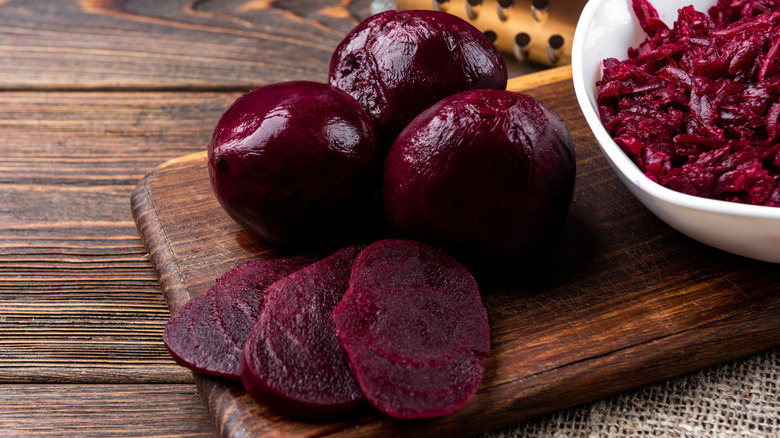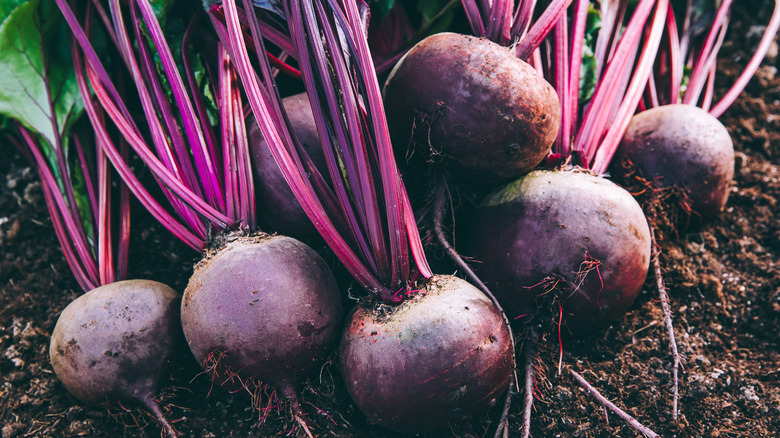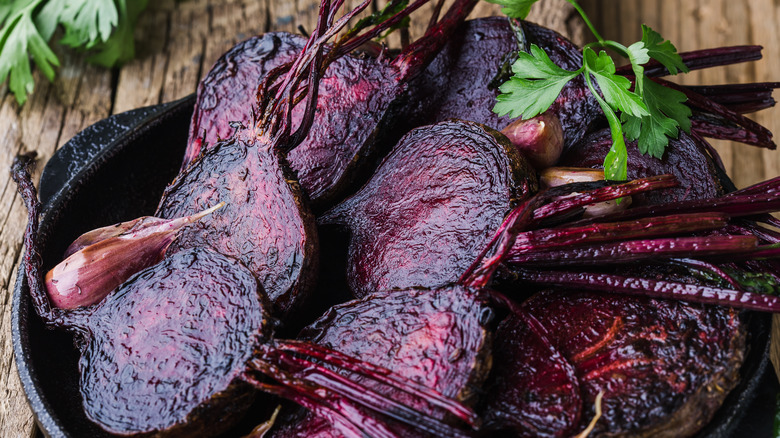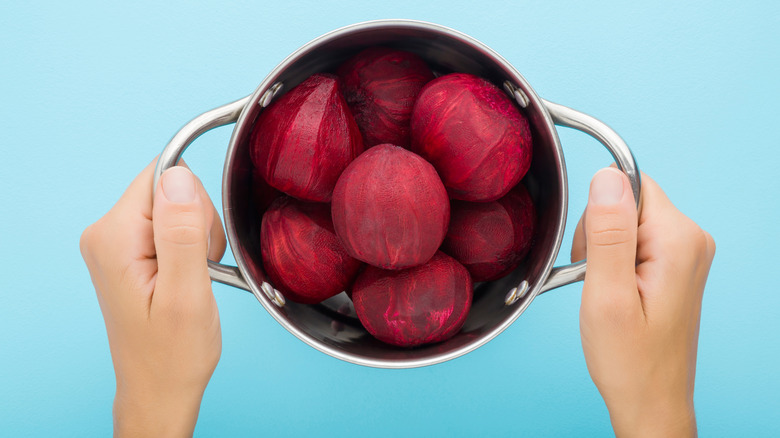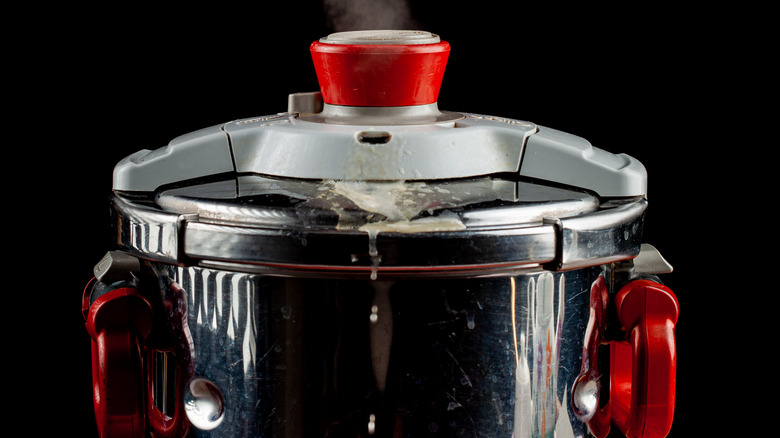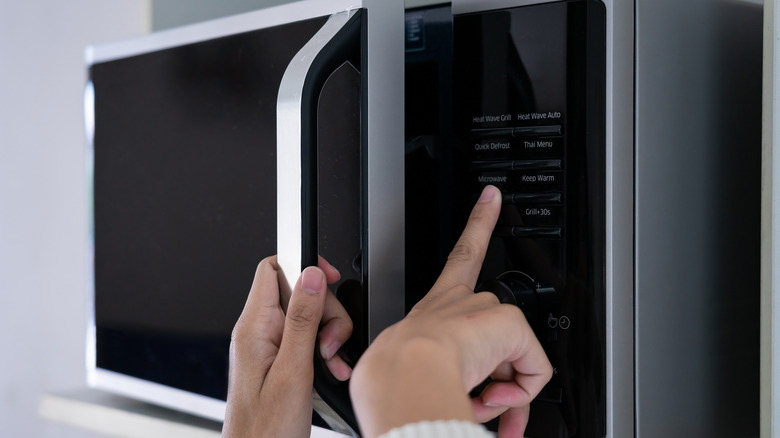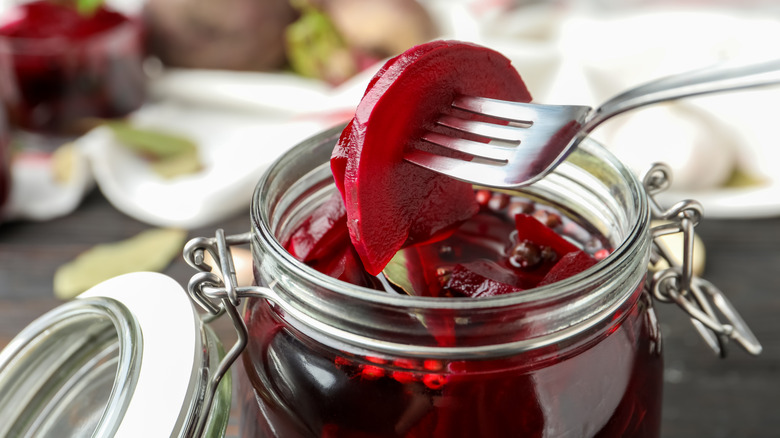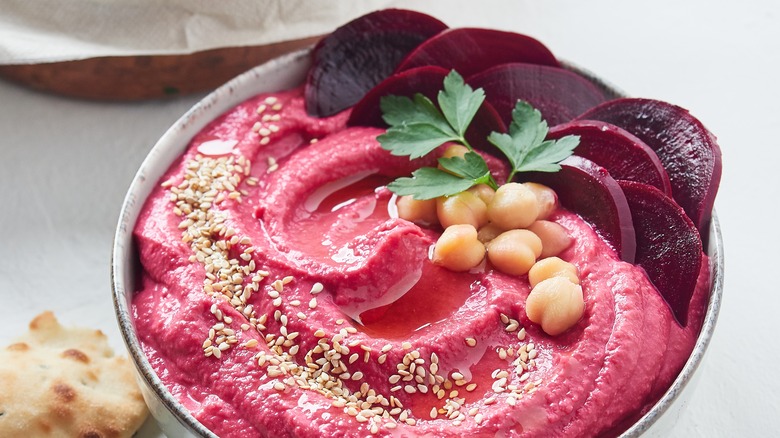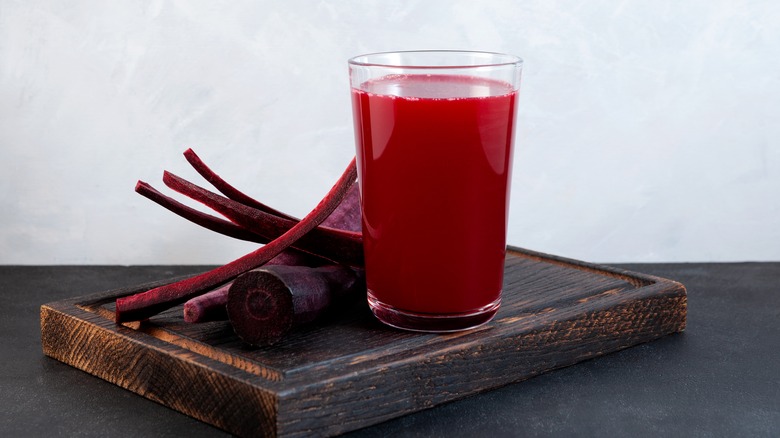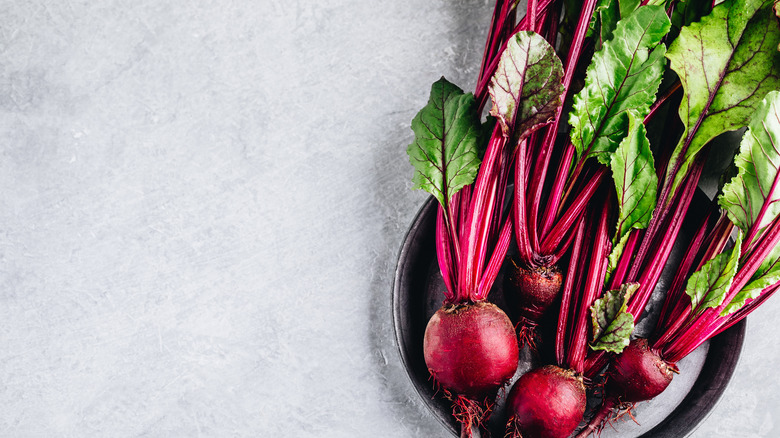9 Different Ways You Can Prepare Beets
Beets get a bad rap, but it is totally undeserved. This root vegetable is a nutritional powerhouse, and when properly prepared, it is sweet and delicious. Maybe you are intimidated by beets because you've never cooked them before, or maybe you have bad memories of being forced to eat canned beets as child, but you shouldn't let that stop you from trying them now. Raw or roasted, pickled or steamed, beets are the perfect complement to many main courses and salads. Plus, their vivid color makes them great for entertaining.
Beets are a superfood. Low in calories but packed with nutrition, a single serving of beets has just 44 calories but provides 20% of the recommended daily allowance of folate (per Healthline). Beets are also a good source of other important minerals such as copper, manganese, and potassium.
Red is the most common color for beets, but even red beets range from light to dark. You can also find golden beets, white beets, striped beets, and many others, especially if you frequent farmers' markets. All are tasty, but look out — they may stain your hands!
1. You can try beets raw
Heat can reduce any vegetable's nutritional value, so eating beets raw is probably the healthiest way to consume them. Choose fresh beets that are firm to the touch. You might find them with the greens still attached, and that's great. According to Consumer Reports, beet greens are a superfood on their own and can be used in many recipes. If you leave them on, they will draw moisture from the beets and cause them to lose volume.
Beets are a root vegetable, so yours might be dirty. Once you have removed the greens, brush any dirt off the beets, then scrub with a vegetable brush under running water. Grating them is the quickest and easiest way to prepare raw beets. You can grate them with a food processor or by hand. Wear rubber gloves if you grate them by hand, or just be prepared for some sideways glances at your beet-stained hands. To serve, simply toss with oil and vinegar or a mustard vinaigrette. Add other crunchy vegetables like carrots or jicama for a twist, or serve over a bed of mixed field greens. You can also try this raw beet and cherry tomato salad with Manchego cheese and walnuts.
2. Beets are delicious roasted
Roasting beets is one of the most flavorful ways to prepare this vegetable, as roasting brings out their natural sweetness. Making roasted beets is pretty straightforward: simply cook them in a dry oven under high heat until you can easily pierce them with a fork. If your beets are small, you can roast them whole. You should halve or quarter larger beets, making sure that the pieces are about the same size. If not, the smaller pieces will be overcooked by the time the larger pieces are done. Once cool, peel the beets by slipping off the skins by hand.
Roasted beets are delicious on their own with just a little oil, salt, and pepper. They are also a great addition to a simple salad of field greens, in salads like this beet salad with marinated radicchio and fresh goat cheese or this apple beet ginger salad, or even in beet soup.
3. You can boil beets
You can boil beets to serve on their own or to use in another recipe. Choose beets of similar size so that they take the same amount of time to cook, and boil them until the beets pierce easily with a fork. Drain the beets (the water will be bright red!) and let them cool.
Boiled and cooled beets are easy to peel. The skin should slide off when you apply just a small amount of pressure with your hands. Sliced, boiled beets make a lovely side dish. Simply squeeze half a lemon over the beets or drizzle with olive oil, then sprinkle with salt, pepper, and dill or parsley. If you are entertaining, use the bright color of boiled beets for a lively presentation. Try fanning them on a solid white plate to really make the color pop and garnish with bright green parsley for a note of contrast. You can also add slices of tart Granny Smith apples or fresh orange.
4. Steam your beets
Steaming beets is a great alternative to boiling them. Boiling beets slightly reduces their nutritional value — all that red water you pour down the drain includes some of the vitamins and minerals found in beets. Steaming beets does not use as much water as boiling, so it does not cause as much nutritional loss. Plus, it takes less time!
You can steam your cleaned, trimmed beets by placing them in a steaming basket over boiling water and leaving them there until they are fork tender. You can also steam beets in an Instant Pot. One advantage of steaming them in an Instant Pot is that you can turn it on and walk away. Whether you steam the beets on the stove or in a pressure cooker, let them cool before peeling. Slice and serve with lemon juice, olive oil, and a little salt and pepper, or use them in another recipe like this easy beet salad.
5. Try microwaving beets
Microwaving beets is even faster than boiling or steaming them and provides a similar result. To microwave beets, cover the bottom of a microwave-safe bowl with water, place the cleaned and trimmed beets in the bowl, and cover with plastic wrap or a reusable silicone cover. After the beets have cooled, they're ready to be peeled. Your microwaved beets can be used in any recipe or served as a side dish.
Microwaving beets works best for small beets or beets that have been quartered. Larger beets may take so long to cook in the microwave that they take on a rubbery texture. Also, this technique is best for cooking just a few beets. If you want to prepare many beets at once, boiling, steaming, or roasting them makes more sense. Cooking a lot of beets in the microwave means spending a lot of time opening the microwave, checking the beets, then putting them back in. With the other methods, you can prep many beets at once; stick them in the oven, pot, or steamer, and come back when they are done.
6. Pickle your own beets
Canning and pickling your own beets may sound cumbersome. Not only does canning require working over a hot stove, but it is potentially dangerous. Improper canning can allows the bacterium that causes botulism to thrive and produce toxins, and eating contaminated canned goods can be lethal, according to the Centers for Disease Control and Prevention (CDC). Fortunately, you can make pickled beets overnight in the refrigerator and avoid the hassle and risks of traditional canning.
Refrigerator pickles are a relatively quick and easy way to make this crispy, crunchy side dish. Nothing could be easier than this recipe for pickled beet salad, which requires no heating at all. While it does suggest using a food processor or mandoline to thinly slice the beets, you can use a knife if that's all you have. Pickled beets are the perfect complement to grilled fish or meat, a perfect side dish for a summer barbecue.
7. Add beets to hummus
Hummus is Middle Eastern in origin but has been a lunchtime staple worldwide for some time now. Take a quick walk through the deli section of your local grocery store, and you will find many brands and varieties of hummus. While hummus is a healthy choice in general, you can make it even healthier by making it yourself. All you need is a food processor.
Hummus is a puree of chickpeas, tahini, olive oil, and lemon juice. You can adjust the proportions to your taste. For example, you can reduce or omit the tahini and olive oil to make it low-fat or fat-free. Some popular variations of hummus include olive, roasted red pepper, or roasted garlic, but you can also make hummus with roasted beets. The sweetness of the beets contrasts with the savory flavor of hummus. Adding beets changes the color from tan to pink, which makes for a fun presentation. Try serving three or four varieties of hummus alongside cut vegetables and pita wedges.
For an even healthier take, try this beet hummus that leaves out the chickpeas entirely. This version of hummus is a bright reddish-pink and will delight your guests.
8. Beet juice can improve athletic performance
If you want to reap the nutritional benefits of beets but just can't make yourself eat them, try making your own beet juice. Several studies have demonstrated that beet juice improves cardiovascular endurance by increasing efficiency. Runners who consumed beet juice were able to decrease their race times and increase their sprinting speed (per the Journal of Applied Physiology and the European Journal of Applied Physiology, respectively, via Runner's World). Cyclists who consumed beet juice were able to ride for a longer period, according to a separate study published in the Journal of Applied Physiology (via the University of Exeter). Nitrates, a compound found in dark, green leafy vegetables like beet greens, are responsible for this effect. The body converts nitrates to nitric oxide, which improves blood flow to muscle cells and increases muscle efficiency, per Runner's World.
The easiest way to make your own beet juice is with a juicer, which can make juice from raw, clean beets. But no need to go out and buy one; you can make beet juice without any special appliances. Simply roast the beets until they are tender, then blend them to create a smooth, chunk-free mixture. Strain if you like. You can add carrots, apples, pears, ginger, or even honey to beet juice.
9. Don't toss the beet greens
Sometimes fresh beets come pretrimmed, but other times they come with the greens attached. If your beets come with the greens, you might as well eat them. Beet greens are packed with nutrients such as calcium, iron, and Vitamin A (per Consumer Reports). To prepare them for serving, discard any wilted or brown leaves, then wash the rest under running water. Separate the stems from the leaves. If you plan to cook the greens, chop the stems and cook them first.
You can use beet greens in place of any other dark, green leafy vegetables like spinach, kale, or Swiss chard. They do have a strong flavor, so not everyone will like them in salads or other raw preparations. However, cooking beet greens makes them more palatable, so try them lightly sauteed with an onion in olive oil and seasoned with salt and pepper. You can also throw chopped beet greens into soups or stews, serve alongside pintos for the Southern staple of beans and greens, or try this spicy beet-green crostini.
